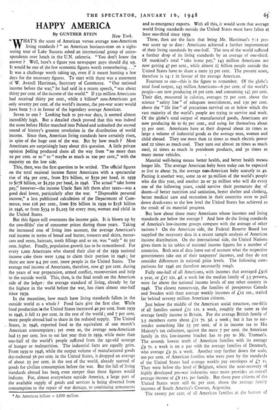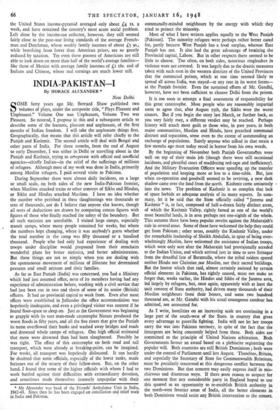HAPPY AMERICA
"WHAT'S the score of American versus average non-American living standards ? " an American business-man on a sight- seeing tour of Lake Success asked an international group of corre- spondents over lunch in the U.N. cafeteria. " You don't know the answer ? Well, here's a figure you newspaper guys should dig up. It would be one of the few economic figures worth remembering...." It was a challenge worth taking up, even if it meant hunting a few days for the necessary figures. To start with there was a statement of W. Averell Harriman, Secretary of Commerce. " Our national income before the war," he had said in a recent speech, "was about thirty per cent. of the income of the world." If 13o million Americans had received thirty per cent., while 2 billion* non-Americans got only seventy per cent. of the world's income, the pre-war score would have been 7: I in favour of the legendary average American.
Seven to one ? Looking back to pre-war days, it seemed almost incredibly high. But a detailed check proved that this was indeed the score before Hitler marched into Poland and unleashed the second round of history's greatest revolution in the distribution of world income. Since then, American living standards have certainly risen, in spite of the huge cost of the war. But by how much ? Most Americans are surprisingly hazy about this question. A little private opinion Dolling produced shots all the way from " no more than so per cent. or so " to " maybe as much as too per cent.," with the majority on the low side.
This, then, was the first question to be settled. The official figures on the total national income flatter Americans with a spectacular rise of 164 per cent., from $72 billion, or $550 per head, in 1939 to $178 billion, or $1,250 per head, in 1946. The actual " take home pay," however—the income Uncle Sam left them after taxes—was a good deal lower, particularly after the war. "Disposable personal income," a less publicised calculation of the Department of Com- merce, rose 126 per cent., from $70 billion in 1939 to $158 billion in 1946, or from $534 to $1,103 for every man, woman and child in the United States.
But this figure still overstates the income gain. It is blown up by the two-fifths' rise of consumer prices during those years. Taking the increased cost of living into account, the average American's real income in terms of bread and butter, trousers and skirts, motor- cars and rents, haircuts, tooth fillings and so on, was " only " 61 per cent. higher. Finally, population growth has to be remembered. For every t,000 Americans who shared their slice of the 1939 national income cake there were 1,094 to claim their portion in 1946 ; for there are now 94 per Cent. more people in the United States. The average real income of Americans, therefore, rose 47 per cent. during the years of war preparation, armed conflict, reconversion and help to the outside world. This, then, is the final result on the American side of the ledger: the average standard of living, already by far the highest in the world before the war, has risen almost one-half since 1939.
In the meantime, how much have living standards fallen. in the outside world as a whole ? Food facts give the first clue. While food production in United States increased 4o per cent. from 1939 to 1946, it fell it per cent. in the rest of the world ; and 7 per cent. more people abroad had to share in the reduCed supply. The United States, in 1946, exported food to the equivalent of one month's American consumption ; yet even so, the average non-American had x5 per cent. less to eat last year than in 1939, while more than one-half of the world'i people suffered from the age-old scourge of hunger or malnutrition. The industrial facts are equally grim. From 1939 to 1946, while the output volume of manufactured goods sky-rocketed 56• per cent. in the United States, it dropped an average of about 25 per cent. in the rest of the world, already starved of goods for civilian consumption before the war. But the fall of living standards abroad has beer} even steeper than these figures would indicate. For, almost everywhere outside America, a large part of the available supply of goods and services is being diverted from consumption to the repair of war damage, to continuing armaments * An American billion = 1,000 million. and to emergency exports. With all this, it would seem that average world living standards outside the United States must have fallen at least one-third since 1939.
These, then are the facts that bring Mr. Harriman's 7:I pre- war score up to date : Americans achieved a further improvement of their living standards by one-half. The rest of the world suffered a further drop of its living standards by an average of one-third. Of mankind's total " take home pay," 143 million Americans are now getting 47 per cent., while almost 21 billion people outside the United States have to share a mere 53 per cent. The present score, therefore is 14:1 in favour of the average American.
Fourteen to one—this is the figure to remember. Of the globe's total food output, 143 million Americans-6 per cent. of the world's
people—are now producing 16 per cent. and consuming 141 per cent. Their diet, measured in calories, averages 72 per cent. above the science " safety line " of adequate nourishment, and 13o per cent. above the " life line " of precarious survival on or below which the vast majority of the world's people are trying to survive and work. Of the globe's total output of manufactured goods, Americans are now producing 6o to 65 per cent., and using for themselves about 55 per cent. Americans have at their disposal about zo times as large a volume of industrial goods as the average man, woman and child abroad. They use more than 12 times as much electric power and 22 times as much coal. They turn out almost 20 times as much steel, 21 times as much in petroleum products, and 5o times as
many motor vehicles. •
Material well-being means better health, and better health means longer life. The average American baby born today can be expected to live to about 70, the average non-American baby scarcely to 4o. Putting it another way, some 20 or 3o million of the world's people who die this year, and another 20 or 3o million who will die every one of the following years, could survive their premature day of doom—if better nutrition and sanitation, better shelter and clothing, better medical care and recreation in their countries were to pull down death-rates to the low level the United States has achieved as the result of its material progress.
But how about those many Americans whose incomes and living standards are below the average ? And how do the living standards of America's low-income groups compare with the average of other nations ? On the American side, the Federal Reserve Board has supplied the necessary data in a recent sample analysis of American income distribution. On the international side, the United Nations gives them in its tables of national income figures for a number of countries. Both sets of data leave out of account what the respective governments take out of their taxpayers' incomes, and they do not consider differences in national price levels. The following com- parisons for 1946 are therefore necessarily rough.
Fully one-half of all Americans, with incomes that averaged £916 a year, or £17 12s. 4d.' a week for the median family of 3.5 persons, were far above the national income levels of any other country in 1946. The closest runners-up, the families of prosperous Canada and Sweden with their average weekly incomes of £12 tos., trailed far behind seventy million American citizens.
Just below the middle of the American social structure, one-fifth of all families earned LH 12s. a week, roughly the same as the average family income in Britain. For the average British family of 3.5 members earns about Dr 7s. 3d. a week ; but it has to sur- render something like 23 per cent. of it in income tax to His Majesty's tax collectors, against the mere 7 per cent. the American family in this low-income bracket has to pay to Mr. Truman's. The seventh lowest tenth of American families with its average £9 7s. a week is on a par with the average families of Denmark, who average £9 5s. a week. Another step further down the scale, ten per cent. of American families who were poor by the standards of the United States had average weekly pay envelopes of £7 Is. They were below the level of Belgium, where the near-recovery of highly developed pre-war industries once more provides an overall average income of £8 Its. per family. But those poor citizens of the United States were still 6o per cent. above the average family incomes of South America's Croesus, Argentina.
The twenty per cent. of all American families at the bottom of the United States income-pyramid averaged only about £4 Is. a week, and have remained the country's most acute social problem. Left alone by the income-tax collector, however, they still seemed fairly close to the post-war living standards of the average French- man and Dutchman, whose weekly family incomes of about £5 9s., while benefiting from lower than American prices, are so greatly reduced by taxation. Yet even those poorest of Americans are still able to look down on more than half of the world's average families— like those of Mexico with average family incomes of Li 16s. and of Indians and Chinese, whose real earnings are much lower still.



































 Previous page
Previous page